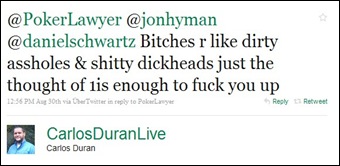The typical sexual harassment case involves a man harassing a woman. Harassment, however, isn’t limited to just man-on-woman. The umbrella of sexual harassment also includes man-on-man, woman-on-woman, and, as recently discussed by the 9th Circuit, women-on-men. In EEOC v. Prospect Airport Services (9th Cir. 9/3/10) [pdf], the 9th Circuit held that that a female co-worker’s “relentless” pursuit of a male employee—which included six months of constant sexual pressure and humiliation—could form the basis of a sexually hostile work environment. In ruling, the court rejected any stereotypes that man would welcome harassment from a female co-worker:
It cannot be assumed that because a man receives sexual advances from a woman that those advances are welcome…. [T]hat is a stereotype…. Title VII is not a beauty contest, and even if Munoz looks like Marilyn Monroe, Lamas might not want to have sex with her, for all sorts of possible reasons. He might feel that fornication is wrong, and that adultery is wrong as is supported by his remark about being a Christian. He might fear her husband. He might fear a sexual harassment complaint or other accusation if her feelings about him changed. He might fear complication in his workday. He might fear that his preoccupation with his deceased wife would take any pleasure out of it. He might just not be attracted to her. He may fear eighteen years of child support payments. He might feel that something was mentally off about a woman that sexually aggressive toward him. Some men might feel that chivalry obligates a man to say yes, but the law does not….
This case serves as a good reminder to review your harassment policy for completeness. Does it cover all kinds of unlawful harassment? Not just the reverse sexual harassment discussed in Prospect Airport Services, but harassment based on race, national origin, religion, age, disability, military status, genetic information, and (where applicable) sexual orientation? If not, it’s time to call your lawyer, update your policy, and re-train your employees on their non-harassment responsibilities.
Presented by Kohrman Jackson & Krantz, with offices in Cleveland and Columbus. For more information, contact Jon Hyman, a partner in our Labor & Employment group, at (216) 736-7226 or jth@kjk.com.



 The NLRB is set to revisit its rules for secret ballot elections for voluntarily recognized unions. If it reverses course, it will administratively do that which Congress has been unable to do—make secret ballot elections that much harder to obtain. The process the NLRB is reconsidering—its 2007 decision in
The NLRB is set to revisit its rules for secret ballot elections for voluntarily recognized unions. If it reverses course, it will administratively do that which Congress has been unable to do—make secret ballot elections that much harder to obtain. The process the NLRB is reconsidering—its 2007 decision in 


 Imagine a sexual harassment EEOC charge which alleges that a corporate executive displayed pornographic images on his computer to a female subordinate. You interview the executive, in addition to everyone else at the company who could have seen the images; everyone denies they existed. In fact, the executive has a plausible explanation. The charging party is a disgruntled, terminated employee who may have accidentally received an email forward of a dirty joke, and is now exaggerating that one isolated incident to extort money through a bogus claim. You have no reason to disbelieve this executive and everyone else at the company. You respond accordingly in the company’s position statement to the EEOC, which finds no probable cause.
Imagine a sexual harassment EEOC charge which alleges that a corporate executive displayed pornographic images on his computer to a female subordinate. You interview the executive, in addition to everyone else at the company who could have seen the images; everyone denies they existed. In fact, the executive has a plausible explanation. The charging party is a disgruntled, terminated employee who may have accidentally received an email forward of a dirty joke, and is now exaggerating that one isolated incident to extort money through a bogus claim. You have no reason to disbelieve this executive and everyone else at the company. You respond accordingly in the company’s position statement to the EEOC, which finds no probable cause.